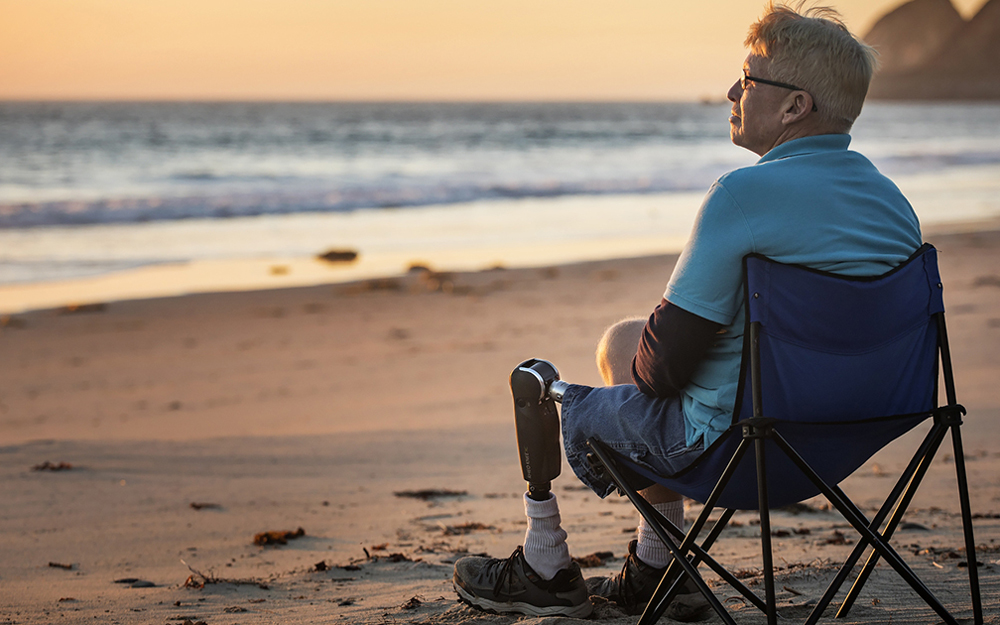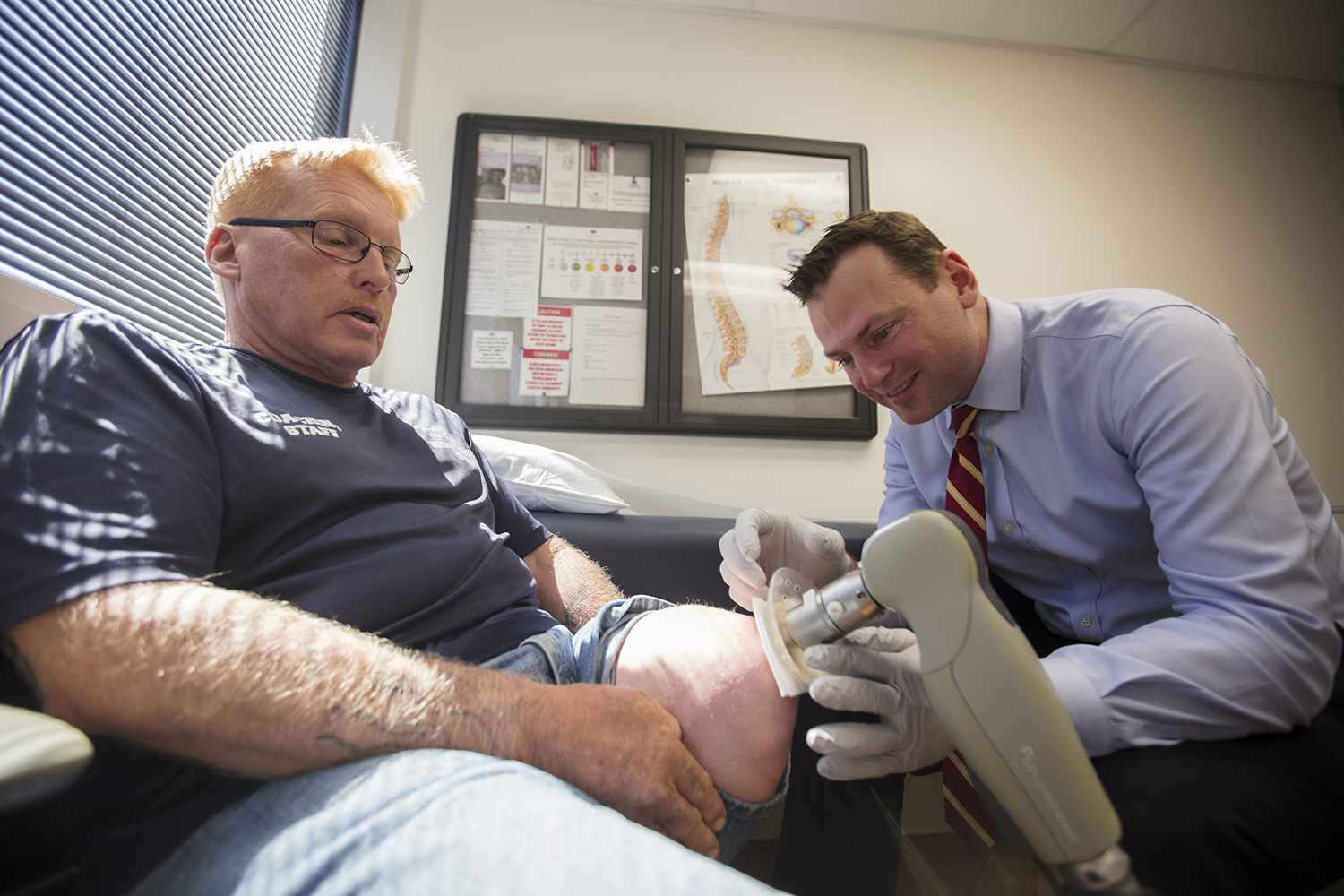Catalyst
Former LAPD Officer Is Back on the Beach with a New Leg
Jan 09, 2018 Cedars-Sinai Staff

Chris Rowles sits on his beach chair, crossing one leg over the other as he enjoys the sunset at Point Mugu. It's a move most of us take for granted, but one he missed for five years.
"This new technology is the closest thing I've seen to actually creating a bionic leg."
He missed other things, too, like walking on the beach, trout fishing in the Sierras, and easily turning from the cutting board to the kitchen sink. All of these were difficult when he was living with a traditional socket prosthetic after losing his left leg to above the knee. Now, he has a new bone-anchored prosthetic leg, which has given him more stability and ease in moving around.
"You don't even think you have a prosthetic leg," says Rowles. "You just go back to when you had two legs. You know you have limitations, but you don’t think about the limitations."
The former Los Angeles Police Department officer was the first in Southern California to undergo this two-part procedure: The first implants a hollow tube into the bone—in his case, the femur; the second secures a rod inside the tube that protrudes from the limb, allowing a prosthetic limb to be snapped on and secured, rather than relying on suction like a traditional prosthetic.
Nearly 2 million people in the U.S. live with limb loss, according to the Amputee Coalition. Over time, many people stop using their prosthetics due to pain, inflammation, skin irritation where the limb meets the skin, blistering and balance problems, says Daniel Christopher Allison, MD. Allison is among the first surgeons to bring this technique to the U.S. It’s been used overseas in Australia and Europe, and is known as osseointegration.
"This new technology is the closest thing I've seen to actually creating a bionic leg, especially when combined with the most up-to-date prosthetic technology," Allison says. "We're taking pure mechanics and really matching it to the biology of the body. It adheres permanently to the skeleton, and it's part of their body—rather than feeling like something that's strapped on to their skin."
A Rough Transition
Staying in shape was just another part of the job for Rowles, who served with the Los Angeles Police Department for 27 years, including 16 years in the metropolitan division, which housed the SWAT and K9 units. At age 42, he had a knee replacement due to arthritis, and was put on light duty because he couldn't run anymore.
In 2008, he noticed an itchy bug bite on the top of his left knee, just over where he had his knee replacement done. This triggered a long battle against a raging infection that rooted inside the knee replacement and returned 11 times. After 28 operations and seven knee replacements, Rowles lost his leg above the knee to the aggressive infection.
For five years, he got by with a traditional socket prosthetic: A socket was fitted to his leg to anchor the prosthetic limb. Rowles never entirely trusted it, saying it was held on with nothing more than "hope and suction." It was irritating on hot days, threw off his natural gait and led him to develop back problems. It was difficult to attach properly, and he often fell.
"One of the things about me—I've never asked for a lot of help," Rowles says. "I probably needed it when I had the socket. Now, I don’t even feel the need to ask anyone for help because I feel so much more confident in myself."

Chris Rowles with Dr. Daniel C. Allison
Stability in the Sand
Rowles initially came to Allison about pain in his other knee, and that’s when he learned about the bone-anchored prosthetic. Allison quickly realized that many of Rowles' problems were related to his amputation and the resulting difficulty using his artificial limb.
"He actually ended up falling because he was losing control, even with one of the most modern prosthetic designs," Allison says. "Eventually, that led him to stop using his prosthetic for a significant part of the day. I could tell this was difficult for him, because he really wanted to get out, enjoy life and help other people—and this was stopping him from doing that."
Rowles says he's able to attach and remove his new prosthetic in a matter of seconds—rather than the time-consuming process of trying to arrange the liners and get the suction just right with his old prosthetic.
"It's been a wonderful improvement for my mobility," Rowles says. "One of the things I've always enjoyed most is being close to the ocean. Before, walking from a parking space and across the sand was difficult. Now, I can take a fairly normal walk across the sand and down to the water."
His stability, confidence and balance restored, Rowles is back to walking on the beach, and he's looking forward to standing on the bank of a river and casting out his fishing line again.
Click below to see a video about Rowles and his Cedars-Sinai experience.
Chris is a grateful patient and supporter of the Campaign for Cedars-Sinai. Learn more about the Campaign.
Are you a grateful patient, family member, volunteer, or loyal supporter? We want to hear from you. Your story can inspire others who may be facing similar challenges—and most importantly, provide hope. Share your story of gratitude or see how others are sharing #CedarsGratitude.


